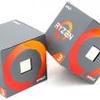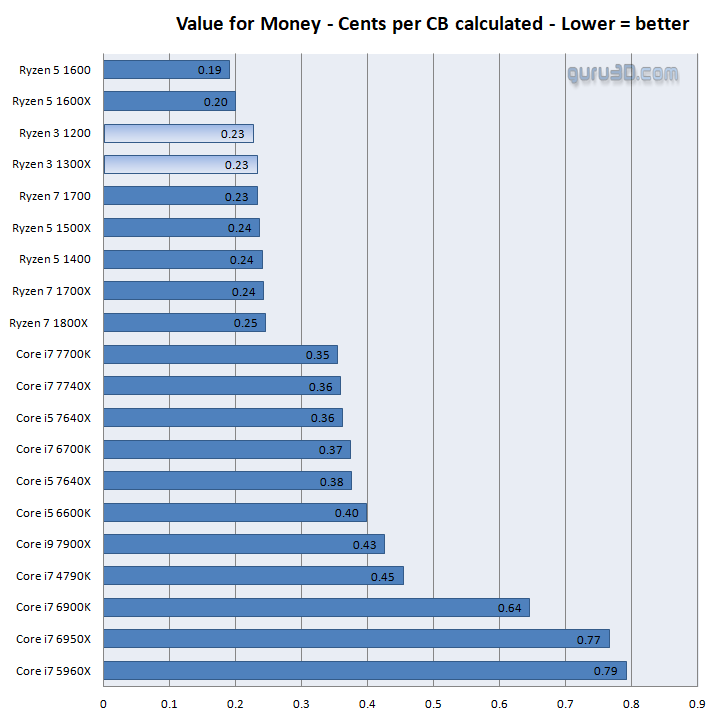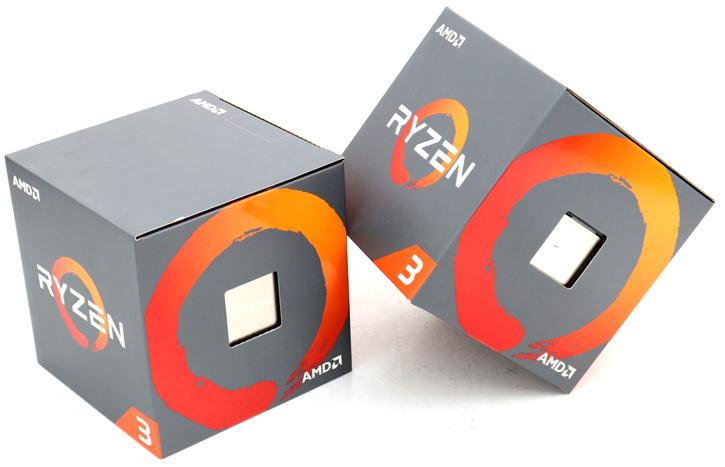Conclusion
Final Words
It is amazing to see how much value you can gain from both Ryzen 3 processors, in fact these might be the best entry-level desktop processors that AMD released, ever. Now, before I continue, you likely (as I did initially) compared the processors to stuff like the 6600K. Human nature, I did the same. And while the Ryzen 3 processors often get close, it is in no way fair as you need to be comparing to the Core i3 series, and not the Core i5 series. So why are there no Core i3 products in our charts you might wonder? Well, when Intel was still providing review samples we asked many times, but they always refused irrevocably to send them out. To date that has not changed. Ryzen 3 rips open a HUGE segment in the market as, for a starting price of 109 USD, you get four cores. You have seen the results, you can clock them to 4 GHz. 4.1 actually also worked on the Ryzen 3 1300X (I do need to to create a little headroom here as the samples that AMD sends out are vanilla cherry picked ones). But that 4 GHz domain has been the same for all Ryzen procs to date. That said, I am honestly impressed as to what Ryzen 3 is offering. Sure, we tested with a GeForce GTX 1080 and that isn't really fair for a 100 dollar processor. However, if you take a B350 motherboard, select your memory wisely and fire off a Ryzen 3 processor on there with, say, a Radeon RX 570 or GeForce GTX 1060, well you are there, rock-solid gaming performance! So yes, Ryzen 3 hits a certian sweet-spot. Make no mistake, I feel that we all need to move to 6 and 8-core processors as these simply offer a snappier and faster PC eco system with all the things we do simultaneously on a PC these days. That doesn't count as much for gaming though, a 4-core CPU in many scenarios offers the best value. And hey, you have seen the results today.
The Experience
The four-core Ryzen 3 series offers solid value for money. I am also happy to report that, with AGESA 1006 (firmware) for the motherboards, the memory compatibility and stability has been enhanced greatly. If you pick your memory right, you will not have any issues. In the BIOS enable the XMP, and you'll boot straight into Windows with your new timings. I've mentioned it a couple of times already, but please read up in this article for some good memory recommendations. Again, I find four-core processors to be less attractive as playing with all the six and eight core processors recently simply feels faster and better in your desktop environment and applications, but it is a very fine and very sufficient processor series though.
Prices and value
So in the above a mathematical plot, we take the CB score from CineBench 15. We normalize the value and basically plot how much money it takes to calculate the CB score. All processors are clocked at default frequencies, this plot would look different if you'd math in tweaked clock frequencies and thus get higher CB scores. Also you need to take the number of CPU cores into account (as in what number of CPU cores is relevant for you). But this is very simple math, have a peek at the chart (the higher a CPU is positioned the better). Value for money wise (Cinebench) shows that the entire Ryzen lineup offers the perf you get in return for your money. This is a fairly subjective chart as it is based on just one test, but it does paint a certain picture. And please do not confuse the chart as to 'what is the better processor'.
The Gaming Performance
As most of you know, 1080p gaming performance has been a bit of a thing with the Ryzen launch. You will need faster memory to help you out there, hence 2933 MHz is where you need to start. The G.Skill FlareX memories at 3200 Mhz we've been playing around with have amazed me though, but sure, that CL14 kit does come at a price premium. For Ryzen 3, 1080p game performance is a non issue. Recent patches for Hitman and Tomb Raider have shown that performance is on the 'Ryze' quite massively. We also do not believe you'd tie a 500 USD graphics card to Ryzen 3. Hence that RX 570 or GTX 1060 would be a perfect match, and with more GPU limitation your 1080p gaming performance will be as good as a 1000 USD processor. So the 1080p game performance is slowly becoming a non-issue as far as I am concerned, but will come at the expense of more expensive higher-frequency memory (and DDR4 memory is expensive at the moment).
The Memory
We mentioned DDR4 memory a couple of times already; the new AGESA 1006 based BIOSes have improved a lot. 3200 MHz is a non-issue with the right memory, we recommend 2933 MHz or better when you build a gaming rig.
The Power
With this processor now fabbed at 14 nm FinFET the TDP sticks at 65 Watts. A full PC at idle will sit in the 50 Watt range with a dedicated graphics card installed (GeForce GTX 1080 / 16 GB memory / SSD and the motherboard). When we stressed the processors with a Prime 1024M run we reached roughly 100 Watts, that's low enough for what it needs to be. Overall though, this is impressive to see. When we game we hover at 225 ~250 Watts, but obviously that factor is dependant on the type of graphics card you use of course. So yeah, these are really good values with a many core product. No complaints here whatsoever and remember, these are all 8-core parts physically, even that 4-core enabled processor.
The Tweak
Both the Ryzen 3 1200 and 1300X have been able to reach 4000 MHz on all four cores. For the 1200 I even used just the stock AMD cooler for overclocking. We had problems with the ASUS C6 Hero, that one needs a bios update (the multiplier did not kick in in Windows). However, when we moved to a Gigabyte X370 motherboard both procs accepted the 40x multiplier. Use a voltage offset that gets you close or just above 1.4 volts, that was the equilibrium for me on both processors, 100% stable with some pretty average cooling as well. Again lovely.
The conclusion
If there has ever been a processor series that is going to change things in a certain segment, it's Ryzen 3. Quad cores for 109 or 129 USD is just good value. You'll build a normal PC perfect for any normal workload. Intel still has a good deal to offer as well, their dual-core procs (and some models with added dual threads) will have an advantage in gaming thanks to high clocks. Also missing is an IGP of course, people out for just an Internet or HTPC will sway away. But when you build a gaming PC with a dedicated graphics solution, the sky is the limit. We do need to factor in though that for Ryzen gaming you need reasonably fast frequency memory, and that is more expensive. If you are not an overclocker, go for the Ryzen 3 1300X with its snazzy clocks and extra 200 MHz XFR range. If you are a processor tweaker (and really that takes like 5 minutes to do so) then the Ryzen 3 1200 is pure gold. I am not saying that all processors will reach 4 GHz, but the chance and likelihood they can is certainly high. With the latest motherboard BIOSes (AGESA 1006) and the right choice in memory, the issues there are gone as well. Combined with a B350 motherboard and SSD that leaves you with a really properly fast enough PC for your everyday workload and gaming experiences. Well done AMD, as both these processors are purely and truly great value.
ATH +++
- Hilbert out
- Sign up to receive a notice when we publish a new article
- Or go back to Guru3D's front page.
“A mind needs books as a sword needs a whetstone, if it is to keep its edge.”




